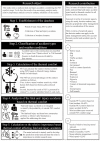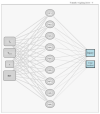Exploring Fatalities and Injuries in Construction by Considering Thermal Comfort Using Uncertainty and Relative Importance Analysis
- PMID: 34071083
- PMCID: PMC8197104
- DOI: 10.3390/ijerph18115573
Exploring Fatalities and Injuries in Construction by Considering Thermal Comfort Using Uncertainty and Relative Importance Analysis
Abstract
Fatal injury and accidents in the construction industry occur under the influence of outdoor weather conditions such as temperature, humidity and wind speed in all four seasons. Previous research in this area has focused on hot and cold weather conditions: hot weather causes heat rash, heat cramps and heat fainting, while cold weather causes fatigue, lumbago, and cold finger sensations. However, other weather conditions are also associated with, and cause, fatal injury and accidents. Accordingly, this study analyzes injury and fatal accidents in the construction industry based on the physiological equivalent temperature (PET) as it pertains to thermal comfort using an uncertainty analysis. Furthermore, using a neural network, relative importance is analyzed considering injury and fatal accidents. This study is conducted in five steps: (i) Establishment of the database, (ii) Classification of accident types and weather conditions, (iii) Calculation of thermal comfort, (iv) Analysis of injury and fatal accidents based on thermal comfort, and (v) Calculation of the relative importance of thermal comfort during injury and fatal accidents. Via the research process, 5317 fatal incidents and 207,802 injuries are analyzed according to 18 accident types in all seasons. It was found that 'falls', were the most frequent fatal incident and injury (2804 fatal incidents and 71,017 injuries), with most of these occurring during the autumn season. The probabilities of injury and fatal accidents in the 'fall' category are 86.01% and 85.60%, respectively, in the outside comfort ranges. The contribution of this study can provide data for a database on safety management considering weather conditions.
Keywords: deep learning; fatal accident; monte carlo simulation; outdoor thermal comfort; physiological equivalent temperature.
Conflict of interest statement
The authors declare no conflict of interest.
Figures














Similar articles
-
Effects of different exercise types on outdoor thermal comfort in a severe cold city.J Therm Biol. 2022 Oct;109:103330. doi: 10.1016/j.jtherbio.2022.103330. Epub 2022 Sep 17. J Therm Biol. 2022. PMID: 36195400
-
An analysis of influential factors on outdoor thermal comfort in summer.Int J Biometeorol. 2012 Sep;56(5):941-8. doi: 10.1007/s00484-011-0503-9. Epub 2011 Nov 23. Int J Biometeorol. 2012. PMID: 22109103
-
Thermal comfort in Quebec City, Canada: sensitivity analysis of the UTCI and other popular thermal comfort indices in a mid-latitude continental city.Int J Biometeorol. 2016 Apr;60(4):591-603. doi: 10.1007/s00484-015-1054-2. Epub 2015 Sep 8. Int J Biometeorol. 2016. PMID: 26349476
-
Outdoor human thermal perception in various climates: A comprehensive review of approaches, methods and quantification.Sci Total Environ. 2018 Aug 1;631-632:390-406. doi: 10.1016/j.scitotenv.2018.02.276. Epub 2018 Mar 16. Sci Total Environ. 2018. PMID: 29525717 Review.
-
Thermal sensation in outdoor urban spaces: a study in a Tropical Savannah climate, Brazil.Int J Biometeorol. 2020 Mar;64(3):533-545. doi: 10.1007/s00484-019-01830-x. Epub 2019 Dec 3. Int J Biometeorol. 2020. PMID: 31797038 Review.
Cited by
-
Development of Framework for Estimating Fatality-Related Losses in the Korean Construction Industry.Int J Environ Res Public Health. 2021 Aug 20;18(16):8787. doi: 10.3390/ijerph18168787. Int J Environ Res Public Health. 2021. PMID: 34444537 Free PMC article.
-
Comparative Analysis of the National Fatality Rate in Construction Industry Using Time-Series Approach and Equivalent Evaluation Conditions.Int J Environ Res Public Health. 2022 Feb 17;19(4):2312. doi: 10.3390/ijerph19042312. Int J Environ Res Public Health. 2022. PMID: 35206494 Free PMC article.
-
Investigation of the usage of machine learning to explore the impacts of climate change on occupational health: a systematic review and research agenda.Front Public Health. 2025 Jun 16;13:1578558. doi: 10.3389/fpubh.2025.1578558. eCollection 2025. Front Public Health. 2025. PMID: 40589827 Free PMC article.
-
Evaluation of the effect of particulate matter on construction accidents using relative probability.Sci Rep. 2023 Oct 23;13(1):18045. doi: 10.1038/s41598-023-45358-y. Sci Rep. 2023. PMID: 37872208 Free PMC article.
References
-
- Li W., Zhang J., Zhao T., Ren J. Experimental study of an indoor temperature fuzzy control method for thermal comfort and energy saving using wristband device. Build. Environ. 2020:107432. doi: 10.1016/j.buildenv.2020.107432. - DOI
-
- Wong T.K.M., Man S.S., Chan A.H.S. Critical factors for the use or non-use of personal protective equipment amongst construction workers. Saf. Sci. 2020;126:104663. doi: 10.1016/j.ssci.2020.104663. - DOI
Publication types
MeSH terms
LinkOut - more resources
Full Text Sources

